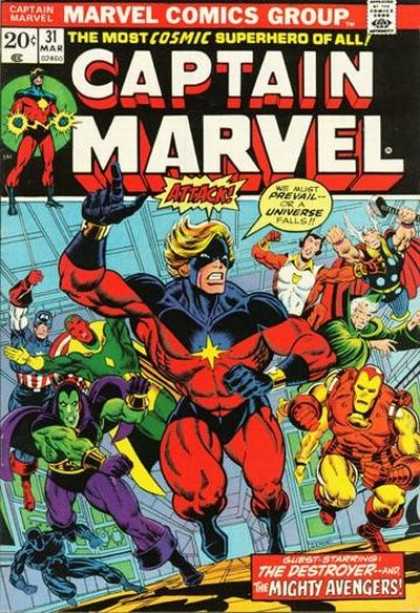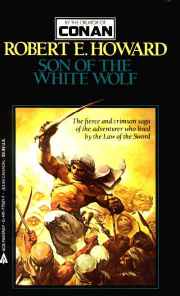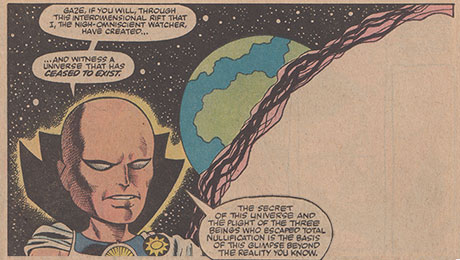

Karen: My selection for this go-round is Captain Marvel #31, from 1974, written and illustrated by Jim Starlin. It wasn't easy to pick a single issue from Starlin's CM run to review, but I think this issue is one of the best. I don't know if anyone at Marvel in the early 70s better exemplified the freedom and creativity that was on display than Starlin. His works were typically on a grand, cosmic scale, and yet, they were also always very personal stories too.
Karen: In the 60s Lee and Kirby gave the readers grand cosmic struggles, but they were mostly devoid of any personal, or human, element. Beings like Galactus and Ego were considered beyond good and evil, and while threatening Earth or the galaxy, there was always this idea that what they did was not truly evil - it was simply their natural behavior. Not so with the menace that Starlin would elevate to that status here.
 The mad Titan Thanos was motivated by strong, very human emotions in his quest for absolute power. He had fallen in love with the personification of Death (this was another continuation from the Lee-Kirby days of giving metaphysical concepts tangible forms). In his zeal to earn her affection, Thanos planned to give Death the gift of galactic genocide. With the help of the Cosmic Cube, a device that could turn thoughts into reality, it appeared he had the means to do so.
The mad Titan Thanos was motivated by strong, very human emotions in his quest for absolute power. He had fallen in love with the personification of Death (this was another continuation from the Lee-Kirby days of giving metaphysical concepts tangible forms). In his zeal to earn her affection, Thanos planned to give Death the gift of galactic genocide. With the help of the Cosmic Cube, a device that could turn thoughts into reality, it appeared he had the means to do so.Karen: Fortunately, our stalwart Kree soldier, Captain Marvel, discovers the plan. Realizing he cannot defeat Thanos alone, he requests the aid of the Avengers. Thanos learns of Mar-Vell's efforts and teleports him, Iron Man, Moondragon, and Drax the Destroyer to his base, as he feels these are his most dangerous foes. He imprisons them, and to take away any last shred of hope, he shows them that he has also shackled Kronos, the supreme being! However, Mar-Vell does manage to free them and they briefly remove the Cube from Thanos. But even without it he is formidable and holds them off until he recovers the device. Finally he disappears, only to reveal that he has used the Cube to turn himself into God!Karen:
 This issue is very fast-paced and exciting. You get everything here: Mar-Vell, the Avengers, the Destroyer, the Titans, tons of aliens, fist fights, psychic battles - it's amazing. I can recall when these issues were coming out and how maddening it was waiting for the next one!
This issue is very fast-paced and exciting. You get everything here: Mar-Vell, the Avengers, the Destroyer, the Titans, tons of aliens, fist fights, psychic battles - it's amazing. I can recall when these issues were coming out and how maddening it was waiting for the next one!Karen: Starlin's art is superb. You can readily see the Ditko and Kirby influences, but Starlin's style is so different that it is entirely original. These are pages that almost pulse with power, and yet they are not without their subtleties too. Starlin is particularly good with the expressions on his characters' faces. I often look at art without reading to see how well the story is conveyed by the artist - and Starlin is a great storyteller.
Karen: This saga still holds up very well and is well worth reading. If you're interested in getting it, it was reprinted in Marvel Masterworks vol. 95.
Doug: This time 'round I thought we'd get a little primitive and return to the Hyborian Age and everyone's favorite barbarian, Conan. Most people associate Conan with scribe Roy Thomas and artist John Buscema, but in this tale we find the pencils ably laid down by John's younger brother Sal. The inks are by Filipino-aritist extraordinairre Rudy Nebres. On, then, with a look back at The Savage Sword of Conan #37 from February 1978.
Doug: I've been a Conan fan for many, many years. The alternate-history of it, tales of a world gone away make these stories close cousins to another favorite -- Tarzan of the Apes.
 Doug: Thomas adapts R.E. Howard's short story, Son of the White Wolf, which actually starred another of Howard's heroes -- El Borak, who was based on Lawrence of Arabia. Here is a plot summary of Howard's story, which Thomas for the most part followed:
Doug: Thomas adapts R.E. Howard's short story, Son of the White Wolf, which actually starred another of Howard's heroes -- El Borak, who was based on Lawrence of Arabia. Here is a plot summary of Howard's story, which Thomas for the most part followed:
"Son of the White Wolf" is another El Borak which saw print only shortly after Howard's death. It's a good one, which manages to encompass a wide scope within a remarkably tight narrative.
During the First World War, a group of Turkish soldiers (fighting on the side of the Germans) mutiny under the megalomaniacal leadership of a madman named Osman Pasha. Osman is a little empire builder. He dreams big, planning to renounce Islam and revive the ancient Turkish religion, worshipping the White Wolf. Under its banner, he means to create a New Turkish Empire while the former empires of Europe batter themselves to dust in the War to End All Wars. Their first stop is a small village, loyal to the Germans, called El Awad.
 Razing the village, they kill all the men but take the women for their wives, including a lovely German spy named Olga Von Bruckmann. But one man, mortally wounded, escapes the massacre and crawls literally miles to bring the word to El Borak. Our impulsive hero sets out on camel alone and without a plan, determine to rescue Olga and hang Osman from the nearest tamarisk...
Razing the village, they kill all the men but take the women for their wives, including a lovely German spy named Olga Von Bruckmann. But one man, mortally wounded, escapes the massacre and crawls literally miles to bring the word to El Borak. Our impulsive hero sets out on camel alone and without a plan, determine to rescue Olga and hang Osman from the nearest tamarisk...
What is most impressive about "Son of the White Wolf" is how REH manages to portray the stakes as sufficiently high that we believe the fate of empires are in the balance. After all, Osman Pasha only has maybe a hundred men, and he so far has taken only one village. Not exactly the stuff of legends. Nonetheless, Howard makes us believe that, unless Osman is stopped and damn quick, he really might succeed in his seemingly mad quest. Given that this is one of the shorter El Borak stories, this achievement is all the more remarkable.
 This is the only El Borak story that makes explicit reference to Lawrence of Arabia, upon whom El Borak was obviously based. We are told that El Borak was living with the Arabs even before Lawrence came along, and now works hand in hand with the great man himself. http://www.pulpanddagger.com/conan/Wolf.html
This is the only El Borak story that makes explicit reference to Lawrence of Arabia, upon whom El Borak was obviously based. We are told that El Borak was living with the Arabs even before Lawrence came along, and now works hand in hand with the great man himself. http://www.pulpanddagger.com/conan/Wolf.html
Doug: Given that this is a Savage Sword story, rather than the four-color monthly Conan the Barbarian, the action is more fierce and ever-bloody. Rape is implied, and an infant and later women are murdered off-screen. Through all of this, Sal Buscema and Rudy Nebres perform quite well. It's hard to imagine that this is the same Sal who pencilled Peter Parker #15, for sale the same month -- this is a Sal Buscema with an edge rarely seen, and who channels his brother often.
Doug: If you've never taken a chance on Savage Sword, Dark Horse (who now owns the Conan Properties license) is reprinting the entire series in the Essentials format. Check 'em out!


















































2 comments:
Back in '74 I was still getting comics on a scattershot basis, probably through my older brother, and CAPTAIN MARVEL #31 was one of those I was lucky enough to have. When I started buying back issues years later to fill the holes in my collection, one of the first things I did was to complete Starlin's brilliant original Thanos saga. As with filmmakers who write as well as direct, I've always had a special place in my heart for comic-book creators who can both write and draw. For this reason, Starlin's CAPTAIN MARVEL and WARLOCK and Steranko's S.H.I.E.L.D. stand out in my mind above all others, no matter how much I admire the work of other Marvel creators who were "merely" writers or artists. No doubt I was spoiled by having these be among the earliest comics I read. "Titans, strive on!"
I'm finally all caught up with this month's Captain Marvel/Thanos posts, and I just had to comment on this issue, since I liked it about as much as Karen did. These issues are just fantastic - almost as good as the Warlock saga. Although influenced by what came before (and I think Ditko much more than Kirby) Starlin's style is really something else.
By the way, I really loved that panel in which Starlin does an homage/satire of da Vinci's Last Supper - obviously with Mar Vell as Jesus (I wonder if that earned them any irate letters?).
Post a Comment